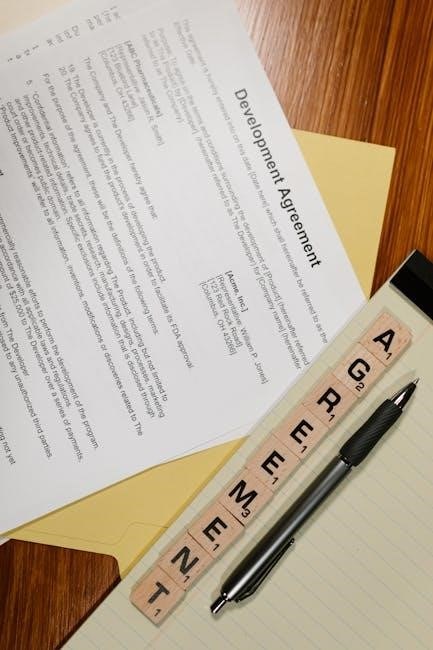A rental termination letter is a formal document used by tenants to notify landlords of their intent to end a tenancy agreement‚ requiring specific details for legal compliance;
1.1 Purpose of the Letter
The purpose of a termination of rental agreement letter is to formally notify the landlord of the tenant’s intent to end the tenancy. This document ensures the landlord is informed of the termination date and provides clarity on the tenant’s plan to vacate the property. It also serves as legal proof of compliance with the lease agreement terms‚ protecting both parties’ rights.
1.2 Importance of a Formal Notice
A formal termination notice is crucial for legally ending a tenancy‚ providing both tenant and landlord with clear documentation. It ensures compliance with the lease agreement terms and protects both parties from potential disputes. This written record establishes a clear timeline and responsibilities‚ maintaining professionalism and avoiding misunderstandings during the transition.
Key Elements of a Termination Letter
A termination letter must include the tenant’s and landlord’s information‚ property address‚ lease details‚ termination date‚ and signature to ensure clarity and legal validity.
2.1 Tenant and Landlord Information
The termination letter must include the tenant’s and landlord’s full names and current addresses. This ensures clarity and verifies the identities of both parties involved in the agreement. Accurate contact information is essential for legal compliance and future communication. Including these details helps prevent disputes and ensures the letter is legally binding. Use placeholders like [Tenant’s Name] and [Landlord’s Name] for customization.
2.2 Property Address and Lease Details
The termination letter must include the property address and specific lease details‚ such as the lease start and end dates; This ensures clarity and confirms the agreement being terminated. Including the lease agreement date and any relevant identifiers helps prevent disputes. Use placeholders like [Property Address] and [Lease Agreement Date] for easy customization and accuracy. This section is critical for legal compliance and ensures both parties are on the same page regarding the termination.
2.3 Termination Date and Notice Period
The letter must include the termination date and notice period‚ ensuring compliance with the lease agreement and local laws. The termination date should be clearly stated‚ along with the required notice period‚ which varies by jurisdiction. Tenants must provide adequate notice‚ typically 30 or 60 days‚ depending on the lease terms. The date format should be specific‚ such as MM/DD/YYYY‚ to avoid ambiguity. This ensures both parties understand the timeline for vacating the property.
2.4 Signature and Date
The letter must include the tenant’s signature and the date it was signed. This ensures the document is legally binding and acknowledges the tenant’s intent to terminate. Both the tenant and landlord should sign a copy‚ with the tenant retaining a signed version for records. The date provides clarity on when the termination was officially initiated‚ avoiding disputes. Including contact information is also recommended for further communication. Proof of service‚ such as certified mail‚ may be required to confirm delivery. Tenants should keep a copy of the signed letter and any related correspondence. This formalizes the process and protects both parties. A witness signature may also be included for additional verification‚ depending on local regulations. The letter should be notarized if required by law to ensure authenticity. Tenants should ensure all sections are completed accurately before submission. This step is crucial for a smooth termination process. Proper documentation helps prevent legal complications and ensures compliance with the lease agreement. Failure to include a signature or date may render the notice invalid. Therefore‚ attention to detail is essential. The tenant should also keep a record of when and how the letter was delivered to the landlord. This provides proof of compliance with the required notice period. Many tenants choose to send the letter via certified mail with a return receipt‚ ensuring there is a record of delivery. This step is particularly important in jurisdictions where proof of service is required for legal purposes. By including all necessary details‚ the tenant can ensure the termination process is handled professionally and lawfully. This approach minimizes potential conflicts and provides a clear record of the agreement’s end. It also demonstrates the tenant’s commitment to fulfilling their obligations responsibly. In some cases‚ tenants may need to provide additional documentation‚ such as a notarized affidavit‚ to support the termination. However‚ this is less common and typically required only in specific circumstances. Overall‚ the signature and date are vital components of the termination letter‚ ensuring its validity and enforceability. Tenants should double-check these details before finalizing the document to avoid any legal issues. Proper execution of the letter helps maintain a positive relationship with the landlord‚ even as the tenancy comes to an end. This professionalism is key to a mutually respectful termination process. Tenants should also be prepared to provide the landlord with a forwarding address for returning the security deposit. Including this information in the letter can streamline the process and ensure timely return of the deposit. Additionally‚ tenants may want to request a walk-through inspection with the landlord to assess the property’s condition before vacating. This can help avoid disputes over damage or repairs. By addressing these details in the termination letter‚ tenants can ensure a smooth transition and protect their interests. The letter should also reference any applicable state or local laws governing the termination process. This demonstrates the tenant’s understanding of their legal obligations and ensures compliance with relevant regulations. Tenants should consult their lease agreement to confirm the specific requirements for termination in their jurisdiction. This step is crucial for avoiding penalties or legal challenges. Many tenants find it helpful to use a termination letter template to ensure all necessary elements are included. These templates are widely available online and can be customized to fit individual circumstances. Using a template can save time and reduce the risk of omitting important details; Tenants should carefully review the template to ensure it aligns with their specific situation and local laws. Once the letter is complete‚ tenants should make multiple copies for their records and any relevant parties. This ensures that all parties have a clear understanding of the termination terms. Proper documentation is essential for protecting the tenant’s rights and avoiding future disputes. Tenants should also be aware of any fees associated with early termination‚ as specified in the lease agreement. Understanding these costs can help tenants plan financially and avoid unexpected expenses. Including a statement acknowledging these fees in the termination letter can provide clarity and prevent misunderstandings. By addressing all necessary components‚ the termination letter serves as a comprehensive and legally sound document. It formalizes the tenant’s intention to end the tenancy and outlines the terms under which the agreement will be terminated. This clear communication helps maintain a positive relationship with the landlord and ensures a smooth transition. Tenants should prioritize clarity and completeness when drafting the letter to achieve these goals. The termination letter is a critical step in ending a tenancy‚ and its proper execution is essential for a hassle-free process. Tenants should approach this task with care and attention to detail to ensure their rights are protected and their obligations are fulfilled. By following the guidelines outlined in the termination letter‚ tenants can navigate the process confidently and efficiently. This approach not only ensures legal compliance but also maintains a professional and respectful relationship with the landlord. Tenants who take the time to craft a well-drafted termination letter demonstrate their responsibility and commitment to fair dealings. This can have long-term benefits‚ as landlords are more likely to provide positive references for tenants who handle the termination process professionally. Tenants should also consider the timing of the letter‚ ensuring it is delivered within the required notice period. This demonstrates respect for the lease agreement and avoids potential penalties for improper termination. By adhering to the specified notice period‚ tenants can maintain their financial and legal standing. The termination letter serves as formal notice‚ initiating the process of ending the tenancy. It is a crucial document that requires careful preparation and attention to detail. Tenants should approach this task methodically‚ ensuring all necessary components are included and properly executed. This ensures the termination process is handled lawfully and respectfully‚ benefiting both parties involved. In summary‚ the signature and date are essential elements of a termination letter‚ providing legal validity and clarity. Tenants must ensure these details are accurately included and that the letter is properly served to the landlord. This responsible approach protects the tenant’s interests and facilitates a smooth transition. By following these steps‚ tenants can confidently navigate the termination process and move forward with peace of mind. The termination letter is a fundamental tool in ending a tenancy agreement‚ and its proper execution is vital for a successful outcome. Tenants should prioritize thoroughness and professionalism when drafting and delivering this document. This ensures the process is handled fairly and lawfully‚ respecting the rights and obligations of both parties. The inclusion of a signature and date‚ along with other essential details‚ makes the termination letter a complete and legally binding document. Tenants who take the time to craft a well-prepared letter demonstrate their commitment to responsible tenancy and professional conduct. This approach not only protects their legal standing but also maintains a positive relationship with the landlord‚ which can be beneficial in the long run. The termination letter is more than just a formal notice; it is a testament to the tenant’s accountability and respect for the lease agreement. By ensuring all elements are included and properly executed‚ tenants can ensure a smooth and respectful termination process. This attention to detail is essential for avoiding legal complications and maintaining a positive reputation as a tenant. The signature and date are the final steps in creating a valid termination letter‚ marking the official end of the tenancy agreement. Tenants should approach this task with the same care they would any legal document‚ ensuring accuracy and completeness. This responsible approach fosters mutual respect and understanding between the tenant and landlord‚ even as the tenancy comes to a close. The termination letter is a critical document that requires careful drafting and execution. Tenants must ensure that all necessary components‚ including the signature and date‚ are included to guarantee the letter’s validity. This professional approach not only protects the tenant’s rights but also ensures a respectful and lawful conclusion to the tenancy. By taking the time to craft a well-drafted termination letter‚ tenants demonstrate their commitment to fulfilling their obligations and maintaining a positive relationship with their landlord. This level of professionalism is key to a successful and stress-free termination process. The signature and date are the final touches that make the termination letter complete and legally binding. Tenants should double-check these details before finalizing the document to ensure everything is in order. This meticulous approach prevents legal issues and ensures a smooth transition for all parties involved. The termination letter is a significant step in ending a tenancy‚ and its proper execution is essential for a positive outcome. Tenants who prioritize accuracy and completeness in their termination letter can navigate the process with confidence and peace of mind. This responsible approach not only protects their legal interests but also upholds their reputation as reliable tenants. In conclusion‚ the signature and date are vital components of a termination letter. Tenants must ensure these elements are included and accurately executed to guarantee the document’s validity. This professional and thorough approach ensures the termination process is

Sample Termination Letter for Tenants
A sample termination letter provides a professional template for tenants to formally notify landlords of their intent to end the rental agreement‚ ensuring compliance with legal standards.
3.1 Structure and Format
The termination letter should include the tenant’s and landlord’s details‚ property address‚ lease specifics‚ termination date‚ and signature; It must be concise and follow a formal tone to ensure clarity and legal validity.
3.2 Example of a Properly Drafted Letter
A properly drafted termination letter includes the tenant’s name‚ property address‚ lease details‚ and a clear statement of intent to terminate. It should specify the effective termination date‚ reference the lease agreement‚ and provide a signature section for both tenant and landlord. The tone must be formal and precise to ensure legal compliance.

Legal Considerations for Tenants
Tenants must review their lease agreement and understand state-specific laws to ensure compliance with termination procedures‚ avoiding potential legal disputes or penalties for improper termination.
4.1 Reviewing the Lease Agreement
Reviewing the lease agreement is crucial to understand termination clauses‚ notice periods‚ and penalties. Tenants must ensure compliance with contract terms to avoid legal issues or financial losses‚ ensuring a smooth termination process in accordance with the agreement’s stipulations and applicable laws.
4.2 Understanding State-Specific Laws
State-specific laws govern termination processes‚ varying in notice periods and grounds for termination. Tenants must familiarize themselves with local regulations to ensure compliance‚ as failure to adhere can result in legal consequences or penalties‚ emphasizing the importance of understanding regional legal requirements before proceeding with termination.
4.3 Consequences of Improper Termination
Improper termination can lead to legal consequences‚ including penalties‚ fees‚ and potential lawsuits; Tenants may face financial losses or damage to their rental history‚ making it harder to secure future housing. Ensuring compliance with legal procedures is crucial to avoid such outcomes and maintain a positive landlord-tenant relationship.
Mutual Termination of Lease Agreement
A mutual termination occurs when both tenant and landlord agree to end the lease‚ releasing both parties from their obligations and avoiding potential disputes.
5.1 When Both Parties Agree to Terminate
Mutual termination occurs when both tenant and landlord consent to end the lease. This can happen due to mutual convenience‚ property sale‚ or other agreed reasons. A written agreement is essential‚ detailing terms and the effective termination date. This approach avoids legal disputes‚ ensuring a smooth process. Tenants are released from lease obligations‚ providing clarity and closure for both parties.
5.2 Lease Termination Agreement Template
A lease termination agreement template is a document outlining mutual consent to end a tenancy. It includes details like effective termination dates‚ property address‚ and signatures from both parties. This template ensures all terms are clear‚ releasing tenants from lease obligations. It’s legally binding‚ preventing future disputes and formally ending the rental relationship.

Serving the Termination Notice

Serving a termination notice involves delivering it via certified mail or in-person‚ providing proof of service and outlining the tenant’s deadline to vacate the property.
6.1 Delivery Methods and Proof of Service
The termination notice must be delivered via certified mail‚ return receipt requested‚ or in-person to ensure proof of delivery. Landlords may also require electronic delivery.

Tenants should retain a copy of the notice and any proof of service‚ such as a delivery confirmation or signed receipt‚ to verify compliance with legal requirements.
